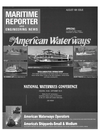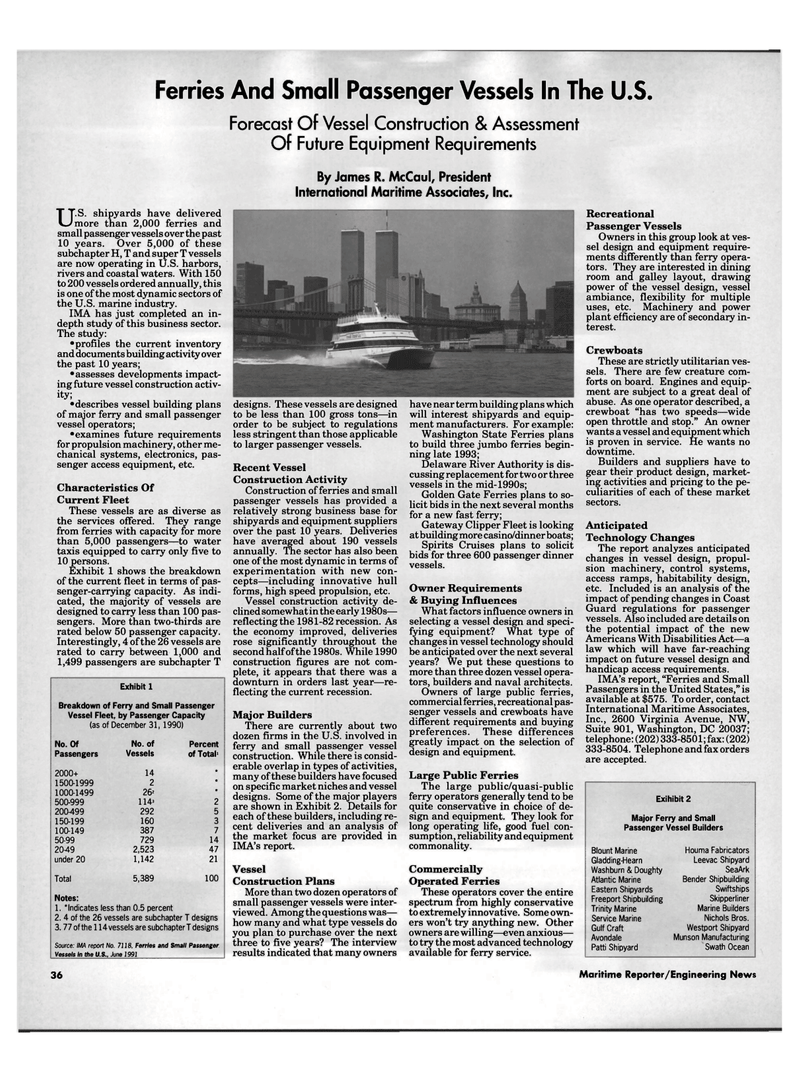
Page 34: of Maritime Reporter Magazine (August 1991)
Read this page in Pdf, Flash or Html5 edition of August 1991 Maritime Reporter Magazine
Ferries And Small Passenger Vessels In The U.S.
Forecast Of Vessel Construction & Assessment
Of Future Equipment Requirements
By James R. McCaul, President
International Maritime Associates, Inc.
U.S. shipyards have delivered more than 2,000 ferries and small passenger vessels over the past 10 years. Over 5,000 of these subchapter H, T and super T vessels are now operating in U.S. harbors, rivers and coastal waters. With 150 to 200 vessels ordered annually, this is one of the most dynamic sectors of the U.S. marine industry.
IMA has just completed an in- depth study of this business sector.
The study: •profiles the current inventory and documents building activity over the past 10 years; •assesses developments impact- ing future vessel construction activ- ity; •describes vessel building plans of major ferry and small passenger vessel operators; •examines future requirements for propulsion machinery, other me- chanical systems, electronics, pas- senger access equipment, etc.
Characteristics Of
Current Fleet
These vessels are as diverse as the services offered. They range from ferries with capacity for more than 5,000 passengers—to water taxis equipped to carry only five to 10 persons.
Exhibit 1 shows the breakdown of the current fleet in terms of pas- senger-carrying capacity. As indi- cated, the majority of vessels are designed to carry less than 100 pas- sengers. More than two-thirds are rated below 50 passenger capacity.
Interestingly, 4 of the 26 vessels are rated to carry between 1,000 and 1,499 passengers are subchapter T
Exhibit 1
Breakdown of Ferry and Small Passenger
Vessel Fleet, by Passenger Capacity (as of December 31, 1990)
No. Of No. of Percent
Passengers Vessels of Total' 2000+ 14 * 1500-1999 2 * 1000-1499 26* * 500-999 1143 2 200499 292 5 150-199 160 3 100-149 387 7 50-99 729 14 2049 2,523 47 under 20 1,142 21
Total 5,389 100
Notes: 1. 'Indicates less than 0.5 percent 2. 4 of the 26 vessels are subchapter T designs 3.77 of the 114 vessels are subchapter T designs
Source: IMA report No. 7118, Ferries and Small Passenger
Vessels in the U.S., June 1991 designs. These vessels are designed to be less than 100 gross tons—in order to be subject to regulations less stringent than those applicable to larger passenger vessels.
Recent Vessel
Construction Activity
Construction of ferries and small passenger vessels has provided a relatively strong business base for shipyards and equipment suppliers over the past 10 years. Deliveries have averaged about 190 vessels annually. The sector has also been one of the most dynamic in terms of experimentation with new con- cepts—including innovative hull forms, high speed propulsion, etc.
Vessel construction activity de- clined somewhat in the early 1980s— reflecting the 1981-82 recession. As the economy improved, deliveries rose significantly throughout the second half of the 1980s. While 1990 construction figures are not com- plete, it appears that there was a downturn in orders last year—re- flecting the current recession.
Major Builders
There are currently about two dozen firms in the U.S. involved in ferry and small passenger vessel construction. While there is consid- erable overlap in types of activities, many of these builders have focused on specific market niches and vessel designs. Some of the major players are shown in Exhibit 2. Details for each of these builders, including re- cent deliveries and an analysis of the market focus are provided in
IMA's report.
Vessel
Construction Plans
More than two dozen operators of small passenger vessels were inter- viewed. Among the questions was— how many and what type vessels do you plan to purchase over the next three to five years? The interview results indicated that many owners have near term building plans which will interest shipyards and equip- ment manufacturers. For example:
Washington State Ferries plans to build three jumbo ferries begin- ning late 1993;
Delaware River Authority is dis- cussing replacement for two or three vessels in the mid-1990s;
Golden Gate Ferries plans to so- licit bids in the next several months for a new fast ferry;
Gateway Clipper Fleet is looking at building more casino/dinner boats;
Spirits Cruises plans to solicit bids for three 600 passenger dinner vessels.
Owner Requirements & Buying Influences
What factors influence owners in selecting a vessel design and speci- fying equipment? What type of changes in vessel technology should be anticipated over the next several years? We put these questions to more than three dozen vessel opera- tors, builders and naval architects.
Owners of large public ferries, commercial ferries, recreational pas- senger vessels and crewboats have different requirements and buying preferences. These differences greatly impact on the selection of design and equipment.
Large Public Ferries
The large public/quasi-public ferry operators generally tend to be quite conservative in choice of de- sign and equipment. They look for long operating life, good fuel con- sumption, reliability and equipment commonality.
Commercially
Operated Ferries
These operators cover the entire spectrum from highly conservative to extremely innovative. Some own- ers won't try anything new. Other owners are willing—even anxious— to tiy the most advanced technology available for ferry service.
Recreational
Passenger Vessels
Owners in this group look at ves- sel design and equipment require- ments differently than ferry opera- tors. They are interested in dining room and galley layout, drawing power of the vessel design, vessel ambiance, flexibility for multiple uses, etc. Machinery and power plant efficiency are of secondary in- terest.
Crewboats
These are strictly utilitarian ves- sels. There are few creature com- forts on board. Engines and equip- ment are subject to a great deal of abuse. As one operator described, a crewboat "has two speeds—wide open throttle and stop." An owner wants a vessel and equipment which is proven in service. He wants no downtime.
Builders and suppliers have to gear their product design, market- ing activities and pricing to the pe- culiarities of each of these market sectors.
Anticipated
Technology Changes
The report analyzes anticipated changes in vessel design, propul- sion machinery, control systems, access ramps, habitability design, etc. Included is an analysis of the impact of pending changes in Coast
Guard regulations for passenger vessels. Also included are details on the potential impact of the new
Americans With Disabilities Act—a law which will have far-reaching impact on future vessel design and handicap access requirements.
IMA's report, "Ferries and Small
Passengers in the United States," is available at $575. To order, contact
International Maritime Associates,
Inc., 2600 Virginia Avenue, NW,
Suite 901, Washington, DC 20037; telephone: (202) 333-8501; fax: (202) 333-8504. Telephone and fax orders are accepted.
Exihibit 2
Major Ferry and Small
Passenger Vessel Builders
Blount Marine Houma Fabricators
Gladding-Hearn Leevac Shipyard
Washburn & Doughty SeaArk
Atlantic Marine Bender Shipbuilding
Eastern Shipyards Swiftships
Freeport Shipbuilding Skipperliner
Trinity Marine Marine Builders
Service Marine Nichols Bros.
Gulf Craft Westport Shipyard
Avondale Munson Manufacturing
Patti Shipyard Swath Ocean 36 Maritime Reporter/Engineering News

 33
33

 35
35
